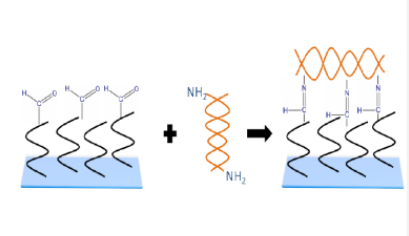上海金畔生物科技有限公司提供各种分子量和基团修饰性聚乙二醇定制服务。
Biotin PEG aldehyde
|
Biotin PEG Aldehyde
Biotin PEG Aldehde (Biotin-PEG-CHO) is one of Nanocs’ chemical reactive biotin PEG derivatives that can label N-terminal amines. Aldehyde group is reactive toward amine, hydrazide or oxyamine groups from pH 5-9. Unlike amine reactive succinimidyl ester group (NHS), aldehyde can react with protonated amines at acidic environment (pH ~4), a condition sometimes required for certain site-specific biotinylation reactions. Aldehyde reacts with amine group to form an intermediate Schiff bond. Further reduction with hydride will form a stable C-N bond. Reaction between aldhyde and other groups allows site-specific conjugation and labeling of biotin tag to desired position on targeted molecules. Resulted biotin can recognize and bind to avidin, streptavidin or neutravidin with high affinity. PEG linker between Biotin and aldehyde offers higher water solubility, less steric hindrance and enhanced stability. Compared to other commonly used biotinylation reagents, Nanocs pegylated biotins are water soluble, more stable and easier to use.
Physical Properties:
- Appearance: White/off-whilte solid;
- Solubility: Soluble in water, DMSO, DMF;
- Reacive group: Aldehyde (-CHO);
- Reactive to: N-terminal amine, primary amine, etc.;
- Functional moiety: D-biotin;
- Reactive toward: avidin, streptavidin or neutravidin;
Storage Conditions:
- Store at -20 0C. Desiccate.
Reaction Procedures:
Generally, a 5- to 10-fold molar excess of Biotin PEG aldehyde over the amount of amine-containing molecules (such as protein or antibody) results in sufficient conjugation.
Materials Required:
- Reaction buffer: Amine-free aqueous buffer, pH 5.0~6.5.
- Biotin PEG aldehyde stock solution: 5-10 mg in 1 mL conjugation buffer.
- Washing solution: Distilled water or any aqueous buffer.
Reaction Steps:
Dissolve ready labeling molecules in pegylation buffer. Estimate the concentration of primary amine groups on the targeted materials. Add Biotin PEG aldehyde stock solution to the targeted conjugation materials with the final concentration keep at least 10 mg/mL. Allow mixture agitates at room temperature for 2~4 hrs at room temperature or overnight 4 0C. After reaction, C=N bond can be reduced by sodium borohydride. Conjugate can be purified either by size exclusion chromatography or dialysis.
- SDS
- DataSheet







